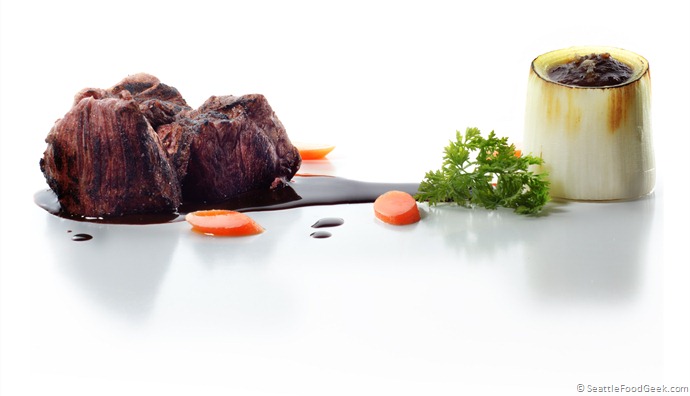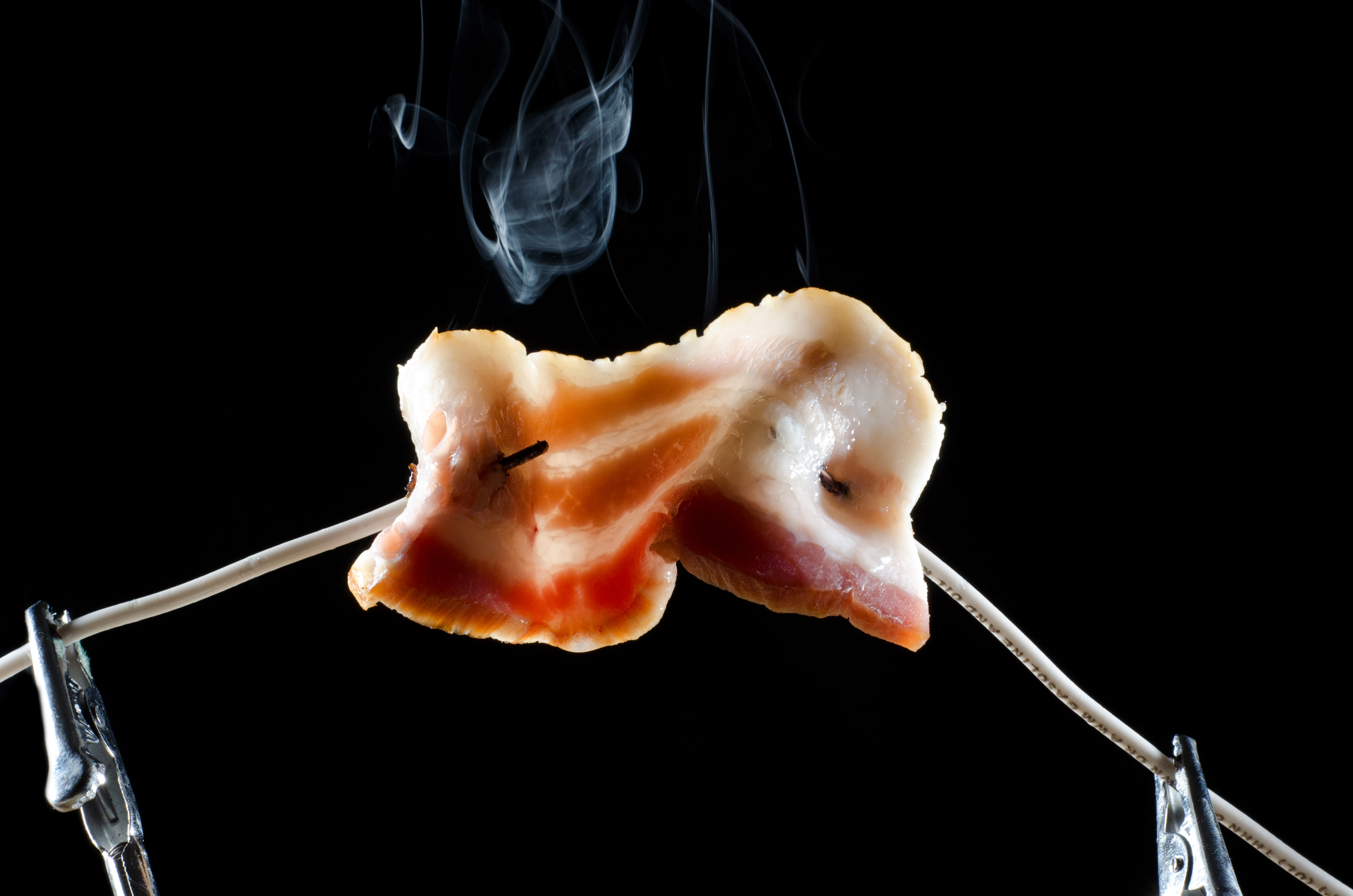
It’s been a while since I cooked a meal for the blog, so when a leg of lamb arrived at my doorstep (care of the lovely folks at the American Lamb board), I took that as a sign that I should get my ass in the kitchen. I’ve been on a carrot kick all spring, and I’ve made several variations of the caramelized carrot soup from Modernist Cuisine. It occurred to me that the deep, sweet flavor of pressure-cooked carrots is not too dissimilar from that of a beef demi-glace (the thick, rich sauce that restaurants often serve over red meat). This is undoubtedly the quickest demi-glace you’ll ever make, and I’ve gotta say, it’s fucking amazing. Vegetarians will throw a parade in my honor.
Thinking about demi-glace also got me in the mood for bone marrow. I’ve seen a few faux marrow preparations in the past and I always find them amusing. However, a big part of the appeal of roasted bone marrow is its decadent, gelatinous texture. For my version, I decided to use a section of leek as a fake bone and achieve a convincing marrow texture by pressure cooking leek and onion, then setting it in a fluid gel. The result was quite a bit darker than roasted bone marrow, but the richness and texture were spot-on.
For the recipe, keep reading…
Carrot Demi-Glace
- 200g carrot juice
- 1g baking soda
- 50g high-quality soy sauce
- 2g cornstarch
- Combine the carrot juice, baking soda and soy sauce in a small saucepan high heat. Bring to a boil, stirring frequently. Reduce the heat to medium and continue simmering the mixture until it turns dark and thickens, about 20 minutes.
- In a small bowl, combine the cornstarch and a few teaspoons of the hot carrot mixture. Stir to combine, then add to the rest of the carrot mixture. Cook 3 minutes more to thicken. Note that the sauce will also thicken as it cools.
Leek “Marrow”
- 1 medium leek
- 50g chopped white onion
- .7g baking soda
- 1 pat butter
- .5g agar agar
- .2g xanthan gum
- Trim the green end of the leek and save for another use. Trim and discard the root end. Cut a 1.5” section from the white end to use as the marrow bone. Remove the inner rings of the leek from this section, leaving 3-4 of the outer rings in place.
- Dice the inner rings of leek, plus other sections of white leek until you have 25g.
- Combine the 25g of leek with the white onion, baking soda and butter in a small, nonreactive bowl (stainless steel, glass or ceramic) that will fit easily into your pressure cooker.
- Add water to the pressure cooker, then place the bowl of leek and onion inside, preferably on a rack so the bowl doesn’t touch the bottom of the pot. Attach the lid and pressure regulator and pressure cook for 20 minutes. Remove from heat, vent and allow to cool.
- Meanwhile, blanch the in-tact section of leek rings in boiling water for one minute, then chill in an ice bath until ready to serve.
- Place the cooked onion and leek mixture over medium-high heat in a small saucepan. Add the agar agar and xanthan gum and stir to combine. Allow the gelling agents to fully hydrate by holding a temperature of at least 83C for 3 minutes, stirring frequently to prevent scorching. Lower the heat, and season to taste with salt. Note: if you plan to serve the marrow with additional salt, you may want to undersalt the marrow at this point.
- Place the leek bone on a plate and spoon in the leek and onion mixture. The mixture will firm slightly as it cools. For a more convincing roasted bone marrow effect, lightly burn the top and sides of the leek with a blowtorch.
- To finish, top with flake sea salt and serve with chervil, parsley or celery leaves tossed in a vinaigrette.
If you chose to omit the lamb and substitute roasted mushrooms, you’d have a pretty exceptional vegetarian dinner on your hands. However, a pile of charred lamb, cooked sous vide for 48 hours at 56C was the perfect way to mop up that delicious carrot demi.

Gorgeous Scott – can you explain a bit more about why you set the marrow ingredients in a bowl over water in a pressure cooker? Also, can you explain the need for baking soda in your recipe? And lastly, at the vegetarian parade in your honor, will you dress as a large green pea?
Great questions! So, for a pressure cooker to work, you need to add water – this is what creates the steam pressure. However, if you were to add the leek and onion to the water in the bottom of the pot, you risk it scorching. Since you can’t see what’s going on inside the pressure cooker, the risk of scorching is even higher. By putting the ingredients in a bowl that doesn’t touch the bottom of the pressure cooker pot, the leek and onion are only exposed to the internal temperature and pressure of the cooker, not to the scorching temperatures of the metal on the burner.
The baking soda trick is something that I picked up from Modernist Cuisine. Adding baking soda raises the pH of the onion and leek, which promotes the Maillard reaction at lower temperatures. This gives us more caramelized foods, straight from the pressure cooker. In the carrot demi, the addition of baking soda helps us get our carrots delightfully dark without boiling off all of the water.
In the parade, I plan to dress as corn on the cob, surrounded by dancers dressed as pats of butter.
I use a pressure cooker for beans and braises – is the mechanism of a pressure canner any different at all from a pressure cooker or is just a matter of a gauge and slightly different design? I’m understanding that pressure cooking is essentially at a much lower temp than trad. cooking, yes? What temp was your leek cooking at? I wish my pressure cooker had a temp gauge.
Do you think you could start a band called Leek Bone?
Finally, so very macho of you to eschew the round, ovarian shape of the pea costume I suggested in favor of the cob of corn. Are the pats of butter wearing 20 mile stares and bright red lipstick like in Robert Plant’s Addicted to Love?
It’s like you read my thoughts 🙂
A pressure cooker and a pressure canner work by exactly the same principle. The difference is that a pressure canner has a pressure gauge so you know exactly what the pressure is inside the pot. AND, because the relationship between barometric pressure and the boiling point of water is given by:
boiling point = 49.161 * Ln (Pressure in inches Hg) + 44.932
We can calculate the acutal temperature inside the pressure canner if we know the pressure. If you don’t want to do the math yourself, you can plug your pressure gauge reading into this site: http://www.csgnetwork.com/prescorh2oboilcalc.html and it will give you the temperature of the water inside. (NOTE: this assumes you live at sea level. If you live at higher altitudes, you’ll need to apply a correction factor.)
And I find corn on the cob to be very feminine – like the cylindrical belly of a teat-laiden hog.
so does that mean you will or won’t start a band called Leek Bone?
Unfortunately, I have a prior contract. If I ever start a band, it will be called Leather Cheerio and we will play reggaeton.
I’m not a fan of lamb, to be completely honest. But this picture does tempt me…I am into sous vide cooking, however, and I was wondering if I could feature this post on my facebook page for The Vak Shack? I sell sous-vide bags for chamber machine (commercial) or non-chamber (home) vacuum sealer machines. If you’re interested, I’d be happy to send you a free sample and you can let me know how they match up? thevakshack@gmail.com
@Amanda, sure thing, feel free to post away! I’m afraid I’m not in the market for sous vide bags right now, but if you get a chamber vacuum sealer back in stock, please shoot me an email. I’m very interested.
Hey Seattlefoodgeek,
Speaking of which, I just recently saw a Sous Vide machine designed for home use.
The problem is that the price tag is $400 and would actually be more than that because I would also have to get a plastic bag sealer and bags (which I currently do not own). Is it worth it? Just how versatile is Sous Vide cooking? Is this really a great method of cooking or is it more of a fad or gimmick?
I cook at home daily and was just curious if adding a sous vide machine would be worth the money?
Thanks
Hi Richard,
Oh boy have you come to the right place for that answer! Yes, sous vide is worth the investment, and no, it is not just a gimmick. In the past two years, I’ve cooked about 95% of my protiens sous vide. As a result, I’ve never accidentally made an overcooked steak, a tough chicken breast, a dry piece of pork, or a weepy piece of salmon. Every food is cooked to absolute perfection, every time, no matter what distractions there may be in the kitchen.
When I’m having a dinner party, I keep all of the hot components warm in individual bags in the sous vide bath. When it’s time to plate a course, I take out the components, apply any last-minute finishes, plate them, and toss the bags in the trash. Even if a course has 10 different components, they’re all served hot, and I often don’t have a single pot or pan to clean when dinner is over.
I use sous vide to cook vegetables, too, but to be honest that’s more out of convienience than the quality of the results. Most veggies cook at 80+C, so the difference between cooking them sous vide and steaming or boiling them is minimal.
And, if you like eggs, sous vide will blow your fracking mind! Whole eggs (in the shell, no vacuum bag) at 64C for 1 hour are other-worldly.
Honestly, the meals I can make with one sous vide bath, a blowtorch and a chef’s knife would blow your mind. This is not a gimmicky technique, my friend. This is the FUTURE!
Hi!
Tried the recepie for leek/onion marrow but found it rather unpleasent as it tasted like bicarb and almost burned. I also tried it with baking powder but in this case the onion/leek mixture turned out as a jelly. Any advice what I’m doing wrong here.
Pingback: MUI7GLkEnc MUI7GLkEnc
Is there any way to achieve the faux marrow without a pressure cooker?
Really cool concept for the marrow, I do something similar to make a vegan liver mousse using dried shiitakes. I actually found this because I was playing with the idea of using it to make a decadent vegan burger, with the idea of the mousse being a fois replacement and I was thinking of what to do for bone marrow to really make it over the top rich, haha.
Really appreciate just getting a recipe and not having to scroll through 8 pages of a story about someone’s niece in Wales who traveled through the Andes before being able to read the recipe hahaha